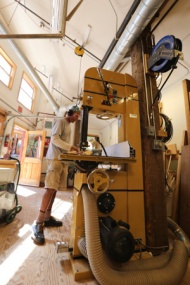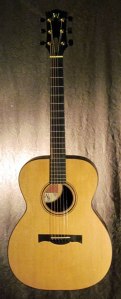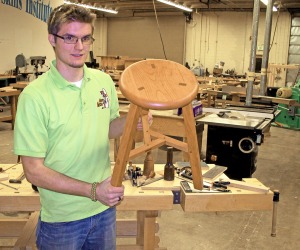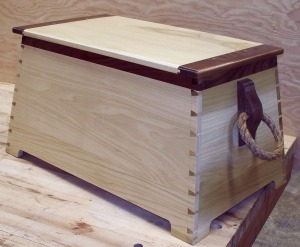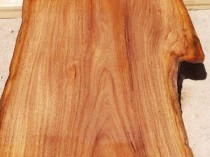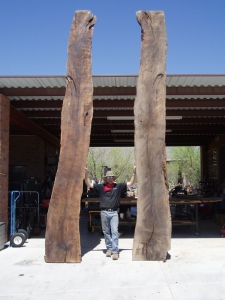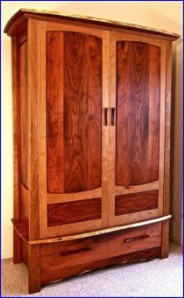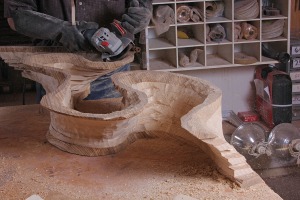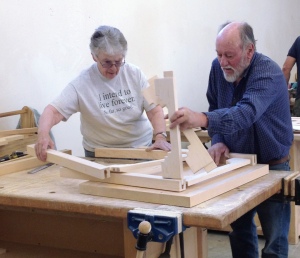
Professor James Rannefeld helps a student prepare for gluing up the base of her Spanish Colonial end table project in the wood shop at UNM Taos.
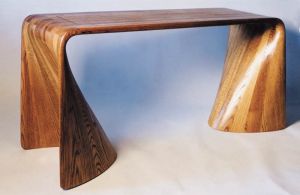
Inspiration bench, in oak. Rannefeld wrote about the laminated joinery technique used to build it for Fine Woodworking magazine in 1983.
James Rannefeld was a restless young man with two science degrees when Taos’ sluggish, mid-70s construction industry forced him to abandon his carpentry career for something more stable.
Determined not to fall back on geology or oceanography, he instead became a woodworker.
Surrounded by fine artists who were selling and shipping their work to collectors around the country, Rannefeld started making his living, in part, by building the crates. A few years later, he was showing his own sculptural woodwork through galleries in Taos and Santa Fe, building custom hardwood doors for designers in Dallas and fine furniture for sale in boutiques on both sides of the Atlantic.
He wrote for Fine Woodworking magazine, and he became an employer, keeping 10 workers busy building his Southwest style designs in a shop near Taos’ plaza. Unscrupulous competitors and changing public tastes eventually sunk that enterprise, but Rannefeld never quit designing and building one-of-a-kind work.
Like many woodworkers, he also became a
teacher. At the University of New Mexico’s branch campus in Taos, he is an associate professor and director of the school’s fine woodworking program, which he founded in the early ’90s. After four decades in woodworking, he still has plenty of lessons to share.
What he doesn’t have is enough students.
The program, which offers a Certificate in Fine Woodworking, has been enrolling 60 to 70 students per semester. Rannefeld said he’d like to see those numbers climb to at least 90 to 100 to help insulate the program from any future cutbacks.
Students seeking certification start with 18 semester hours of woodworking and furniture-making fundamentals. The program’s mission, Rannefeld says, is to “give them the basics. Give them the foundation, and let them build on that.”
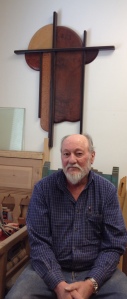
Rannefeld in his office, with his Quattro wall-hung sculpture. The piece is assembled from shaped, solid hardwood.
The core courses are followed by 12 hours of electives, which can include sculpture, lamination, bending, and carving among other techniques. The program also offers an introductory business course and a semester of instruction on Quickbooks accounting.
Some students are intent on pursuing the craft for its own sake; others are fine artists learning to work with wood as an expressive medium. Almost all, he says, recognize the need to preserve the elements of the craft.
On a recent afternoon, the shop was alive with the sound of grinders and dust collectors as some students shaped and smoothed sculptural work while others cut joinery or prepared for assembly. Rannefeld circulated around the shop, stopping at each bench, offering pointers and asking questions.
Later, he shared with me a piece of advice he gives often – a lesson learned early: “Make it better than it has to be. That way you can sleep at night.”
Enrollment for the fall semester at UNM Taos is underway now. Visit http://taos.unm.edu/academics/fine-woodworking.html for more information on the woodworking curriculum.
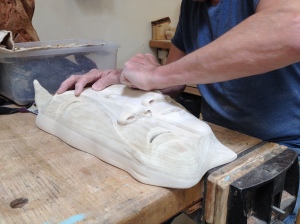
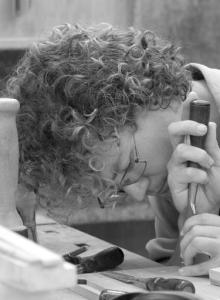 Today I want to share one of the best all-around pieces of woodworking wisdom that anyone has passed on to me in 10 years of writing about the craft. I say woodworking wisdom, because it came from a woodworker, but in truth you could apply it in many arenas. I suppose that is part of what makes it wise. Anyway, it goes like this: “Good craft demands honesty. If you lie to yourself that a joint is good when it is not, things will fall apart.” Simple but true, and it gets to the heart of just about every mistake I’ve ever made in the shop. It’s all too easy, when you want the finished thing in your hands, to let expediency guide your decisions – to do something halfway and hope for the best. And then you get into trouble. Or I do, at any rate. For that simply stated truth I am grateful not to an aging sensei of the craft, but to a remarkable young furniture maker named Chase Ankeny. Chase and I are neighbors, of a sort. I first saw his work on the website for his woodworking alma mater, the College of the Redwoods in Fort Bragg, California. I was then amazed to discover that his home and shop are about 10 minutes’ drive from mine in northwest Albuquerque. Chase grew up in the Albuquerque area. After earning degrees in philosop
Today I want to share one of the best all-around pieces of woodworking wisdom that anyone has passed on to me in 10 years of writing about the craft. I say woodworking wisdom, because it came from a woodworker, but in truth you could apply it in many arenas. I suppose that is part of what makes it wise. Anyway, it goes like this: “Good craft demands honesty. If you lie to yourself that a joint is good when it is not, things will fall apart.” Simple but true, and it gets to the heart of just about every mistake I’ve ever made in the shop. It’s all too easy, when you want the finished thing in your hands, to let expediency guide your decisions – to do something halfway and hope for the best. And then you get into trouble. Or I do, at any rate. For that simply stated truth I am grateful not to an aging sensei of the craft, but to a remarkable young furniture maker named Chase Ankeny. Chase and I are neighbors, of a sort. I first saw his work on the website for his woodworking alma mater, the College of the Redwoods in Fort Bragg, California. I was then amazed to discover that his home and shop are about 10 minutes’ drive from mine in northwest Albuquerque. Chase grew up in the Albuquerque area. After earning degrees in philosop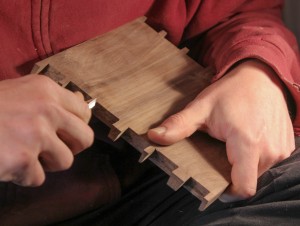 hy and history from the University of New Mexico, he hiked the Pacific Crest Trail before settling on furniture making as a career path. He finished at Redwoods in 2012 and just recently left a job in a production shop here in Albuquerque to devote himself full time to his own furniture-making business. He seems poised for a good start. View his work (at
hy and history from the University of New Mexico, he hiked the Pacific Crest Trail before settling on furniture making as a career path. He finished at Redwoods in 2012 and just recently left a job in a production shop here in Albuquerque to devote himself full time to his own furniture-making business. He seems poised for a good start. View his work (at 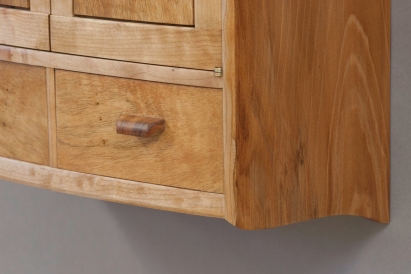 planes that he made while at Redwoods. “There is a moment when you take a board that is square and flat, and put chamfers on it and shape the flatness out of it, that it seems to become real,” he says. “That is what I love the best, the small details that turn the design from something abstract to something embodied.”
planes that he made while at Redwoods. “There is a moment when you take a board that is square and flat, and put chamfers on it and shape the flatness out of it, that it seems to become real,” he says. “That is what I love the best, the small details that turn the design from something abstract to something embodied.”
